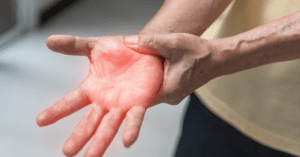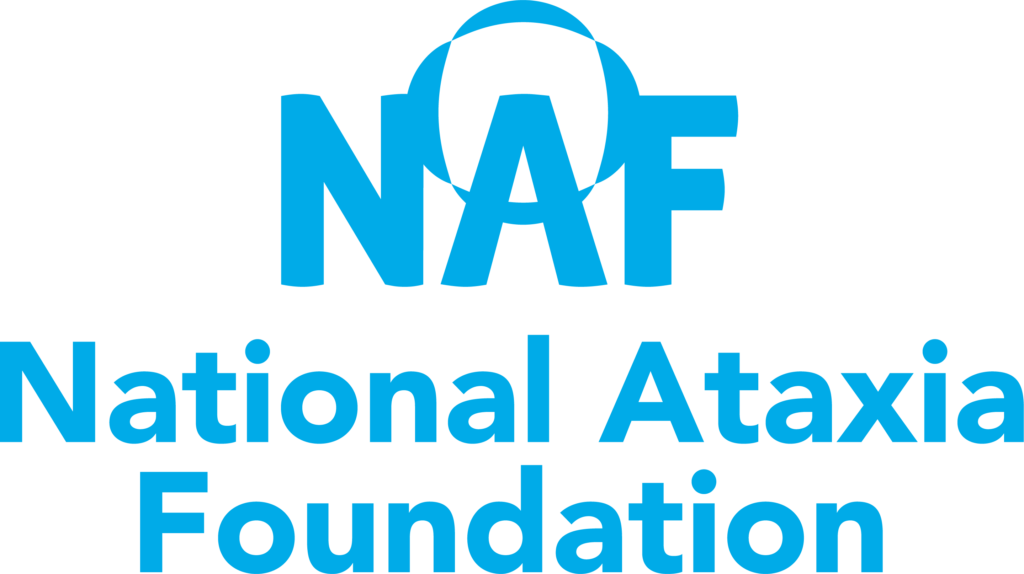
Areflexia, from the Greek word “a”, meaning absence, is a medical condition characterized by the absence or reduction of reflexes. Reflexes are involuntary response triggered by sensory stimuli that are essential for maintaining proper bodily function. When this complex system fails, it shows as areflexia, which causes a variety of symptoms across multiple systems in the body. There are multiple types of areflexia, each with different symptoms and related ataxia type.
Vestibular Areflexia
Vestibular areflexia is characterized by malfunction of the vestibular system, which oversees balance and spatial orientation. Relevant ataxias include RFC1 Ataxia or Cerebellar Ataxia Neuropathy Vestibular Areflexia Syndrome (CANVAS). Patients with this condition frequently report vertigo, dizziness, and difficulty keeping balance. They may sway or stumble, particularly while walking over uneven terrain or changing postures quickly. Nystagmus, an involuntary rhythmic movement of the eyes, may also occur. Vestibular areflexia can have significant impacts on an individual’s quality of life, making it difficult to accomplish daily tasks that require coordination and spatial awareness.
Autonomic Areflexia
Autonomic areflexia results from malfunction in the autonomic nervous system, which regulates involuntary bodily functions such as heart rate, blood pressure, and digestion. Symptoms of autonomic areflexia include orthostatic hypotension, urinary retention, and digestive problems, amongst others. Multiple System Atrophy (MSA) is a common condition associated with autonomic areflexia, which can also be seen in many other ataxias. Individuals with MSA frequently exhibit substantial autonomic dysfunction, which causes symptoms such as dizziness upon standing (often referred to as postural orthostasis), urinary retention, and constipation. Combined with motor symptoms, autonomic dysregulation can contribute to the overall disability from various neurological disorders.
Spinal Areflexia
Spinal Areflexia is the lack or reduction of reflexes mediated by the spinal cord, which affects motor function and coordination. Peripheral neuropathy, a condition in which there is damage to the peripheral nerves that transmit information between the central nervous system and the environment, is a common cause of spinal areflexia. Spinal cord injuries are another major cause of spinal areflexia. Symptoms of spinal areflexia may include muscle weakness, loss of tendon reflexes, and difficulty controlling movement. While spinal areflexia is a rare symptom in sporadic ataxias, it can have a major impact on people’s motor ability. Patients with this condition may present with an unstable gait, clumsiness, and difficulty carrying out fine motor skills.
If you would like to learn more about areflexia, take a look at these resources by the Cleveland Clinic.
Snapshot Written by:Lin (Summer) Dong
Edited by: Sharan Srinivasan, MD
Read Other SCAsource Snapshot Articles

Snapshot: O que é Distonia?
Distonia é uma desordem que afeta a maneira como uma pessoa se move. Mais especificamente, pessoas com distonia têm contrações musculares involuntárias, que podem causar posturas anormais. A distonia pode Read More…

Snapshot: What is Neuropathy?
Our nervous system consists of the central and the peripheral nervous system. The brain and spinal cord are components of our central nervous system (CNS), while the peripheral nervous system Read More…

Snapshot: ¿Cómo miden los médicos la severidad de la ataxia en los pacientes?
La coordinación de movimientos finos y efectivos es esencial en las tareas diarias, como hablar o caminar. La capacidad de orquestar exitosamente estos movimientos se denomina comúnmente “coordinación motora”. Si Read More…
References
Allen KJ, Leslie SW. Autonomic Dysreflexia. [Updated 2023 May 30]. In: StatPearls [Internet]. Treasure Island (FL): StatPearls Publishing; 2024 Jan-. Available from: https://www.ncbi.nlm.nih.gov/books/NBK482434/
Benkirane, M., Da Cunha, D., Marelli, C., Larrieu, L., Renaud, M., Varilh, J., Pointaux, M., Baux, D., Ardouin, O., Vangoethem, C., Taulan, M., Daumas Duport, B., Bergougnoux, A., Corbillé, A.-G., Cossée, M., Juntas Morales, R., Tuffery-Giraud, S., Koenig, M., Isidor, B., & Vincent, M.-C. (2022). RFC1 nonsense and frameshift variants cause canvas: Clues for an unsolved pathophysiology. Brain, 145(11), 3770–3775. https://doi.org/10.1093/brain/awac280
Chacko, F., Pozhekadavil, R., & Poovathingal, M. A. (2019). A case of proximal muscle weakness and areflexia with post exercise facilitation of deep tendon reflexes. Journal of the Neurological Sciences, 405, 268. https://doi.org/10.1016/j.jns.2019.10.1316
Cortese, A., Simone, R., Sullivan, R., Vandrovcova, J., Tariq, H., Yau, W. Y., Humphrey, J., Jaunmuktane, Z., Sivakumar, P., Polke, J., Ilyas, M., Tribollet, E., Tomaselli, P. J., Devigili, G., Callegari, I., Versino, M., Salpietro, V., Efthymiou, S., Kaski, D., … Houlden, H. (2019). Biallelic expansion of an intronic repeat in RFC1 is a common cause of late-onset ataxia. Nature Genetics, 51(4), 649–658. https://doi.org/10.1038/s41588-019-0372-4
Cortese, A., Tozza, S., Yau, W. Y., Rossi, S., Beecroft, S. J., Jaunmuktane, Z., Dyer, Z., Ravenscroft, G., Lamont, P. J., Mossman, S., Chancellor, A., Maisonobe, T., Pereon, Y., Cauquil, C., Colnaghi, S., Mallucci, G., Curro, R., Tomaselli, P. J., Thomas-Black, G., … Reilly, M. M. (2020). Cerebellar ataxia, neuropathy, vestibular areflexia syndrome due to RFC1 repeat expansion. Brain, 143(2), 480–490. https://doi.org/10.1093/brain/awz418
Eftekhar, A., Norton, J. J. S., McDonough, C. M., & Wolpaw, J. R. (2018). Retraining Reflexes: Clinical Translation of Spinal Reflex Operant Conditioning. Neurotherapeutics : the journal of the American Society for Experimental NeuroTherapeutics, 15(3), 669–683. https://doi.org/10.1007/s13311-018-0643-2
Ferreira, S. H., Lopes, C., Abreu, M., Melo, C., Alves, D., & Sousa, R. (2021). Ptosis, areflexia and ataxia in a 4-year-old girl. Pediatrics In Review, 42(Supplement_1). https://doi.org/10.1542/pir.2018-0357
Henke, A. M., Billington, Z. J., & Gater, D. R., Jr (2022). Autonomic Dysfunction and Management after Spinal Cord Injury: A Narrative Review. Journal of personalized medicine, 12(7), 1110. https://doi.org/10.3390/jpm12071110
Klockgether T. (2018). Sporadic adult-onset ataxia. Handbook of clinical neurology, 155, 217–225. https://doi.org/10.1016/B978-0-444-64189-2.00014-7
Krosnick, A. (1964). Achilles tendon areflexia in diabetic patients. JAMA, 190(11). https://doi.org/10.1001/jama.1964.03070240054020
Magistris, M. R., Sukockienė, E., & Truffert, A. (2021). Does impaired conduction of IA afferents explain early tendon areflexia in guillain-barré syndrome? Clinical Neurophysiology, 132(1), 104–105. https://doi.org/10.1016/j.clinph.2020.11.004
Migliaccio, A. A. (2004). Cerebellar ataxia with bilateral vestibulopathy: Description of a syndrome and its characteristic clinical sign. Brain, 127(2), 280–293. https://doi.org/10.1093/brain/awh030
Szmulewicz, D. J., Roberts, L., McLean, C. A., MacDougall, H. G., Halmagyi, G. M., & Storey, E. (2016). Proposed diagnostic criteria for cerebellar ataxia with neuropathy and vestibular areflexia syndrome (canvas). Neurology Clinical Practice, 6(1), 61–68. https://doi.org/10.1212/cpj.0000000000000215
Wenning, G. K., Geser, F., Krismer, F., Seppi, K., Duerr, S., Boesch, S., Köllensperger, M., Goebel, G., Pfeiffer, K. P., Barone, P., Pellecchia, M. T., Quinn, N. P., Koukouni, V., Fowler, C. J., Schrag, A., Mathias, C. J., Giladi, N., Gurevich, T., Dupont, E., Ostergaard, K., … European Multiple System Atrophy Study Group (2013). The natural history of multiple system atrophy: a prospective European cohort study. The Lancet. Neurology, 12(3), 264–274. https://doi.org/10.1016/S1474-4422(12)70327-7
Wu, T. Y., Taylor, J. M., Kilfoyle, D. H., Smith, A. D., McGuinness, B. J., Simpson, M. P.,Walker, E. B., Bergin, P. S., Cleland, J. C., Hutchinson, D. O., Anderson, N. E., Snow, B. J., Anderson, T. J., Paermentier, L. A., Cutfield, N. J., Chancellor, A. M., Mossman, S. S., & Roxburgh, R. H. (2014). Autonomic dysfunction is a major feature of cerebellar ataxia, neuropathy, vestibular areflexia “canvas” syndrome. Brain, 137(10), 2649–2656. https://doi.org/10.1093/brain/awu196
Yamada M. (2022). Neuropathological Findings in Cerebellar Ataxia With Neuropathy and Vestibular Areflexia Syndrome. Brain and nerve, 74(11), 1257–1260. https://doi.org/10.11477/mf.1416202224










